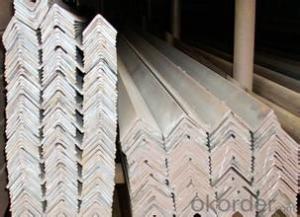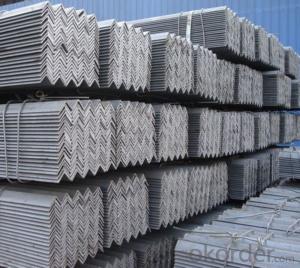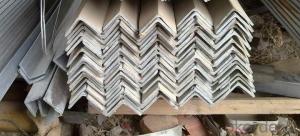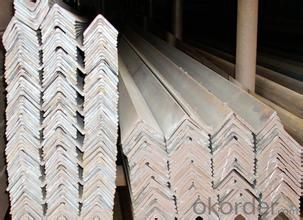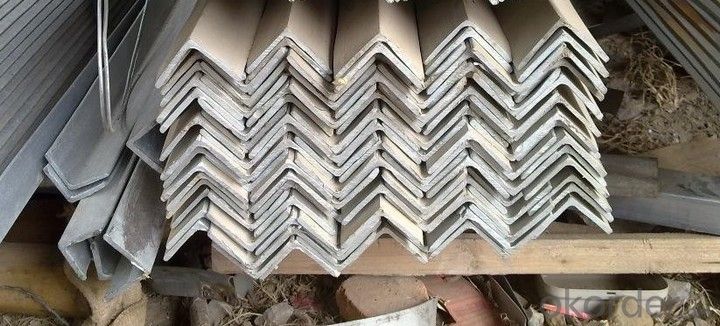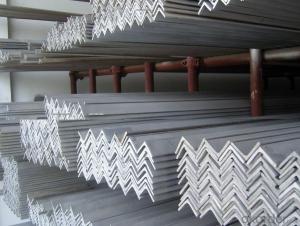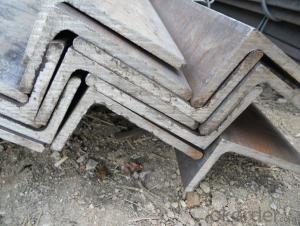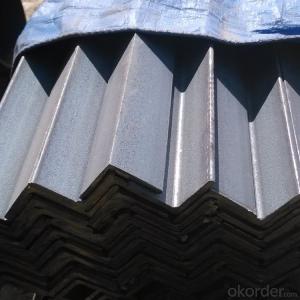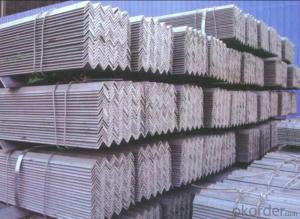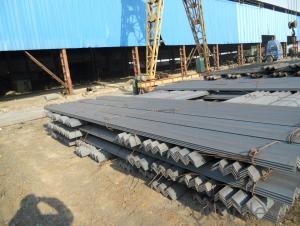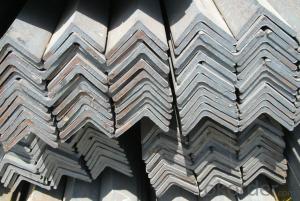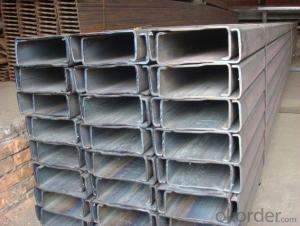DIN1028 galvanized angle steel for construction
- Loading Port:
- Tianjin
- Payment Terms:
- TT OR LC
- Min Order Qty:
- 25 m.t.
- Supply Capability:
- 10000 m.t./month
OKorder Service Pledge
OKorder Financial Service
You Might Also Like
Product Description:
Specifications of Equal Angle Steel
1.Standards: GB
2.Material: GBQ345 or Equivalent
3.Length: 6m, 12m
4. Size:
| Size (mm) | Mass (mm) | Size (mm) | Mass (mm) |
| 100*100*6 | 9.366 | 100*100*10 | 15.120 |
| 100*100*7 | 10.830 | 100*100*12 | 17.898 |
| 100*100*8 | 12.276 |
Usage & Applications of Equal Anlge Steel
Trusses;
Transmission towers;
Telecommunication towers;
Bracing for general structures;
Stiffeners in structural use.
Packaging & Delivery of Equal Angle Steel
1. Transportation: the goods are delivered by truck from mill to loading port, the maximum quantity can be loaded is around 40MTs by each truck. If the order quantity cannot reach the full truck loaded, the transportation cost per ton will be little higher than full load.
2. With bundles and load in 20 feet/40 feet container, or by bulk cargo, also we could do as customer's request.
3. Marks:
Color mark: There will be color marking on both end of the bundle for the cargo delivered by bulk vessel. That makes it easily to distinguish at the destination port.
Tag mark: There will be tag mark tied up on the bundles. The information usually including supplier logo and name, product name, made in China, shipping marks and other information request by the customer.
If loading by container the marking is not needed, but we will prepare it as customers' request.
*If you would like to get our price, please inform us the size, standard/material and quantity. Thank you very much for your attention.
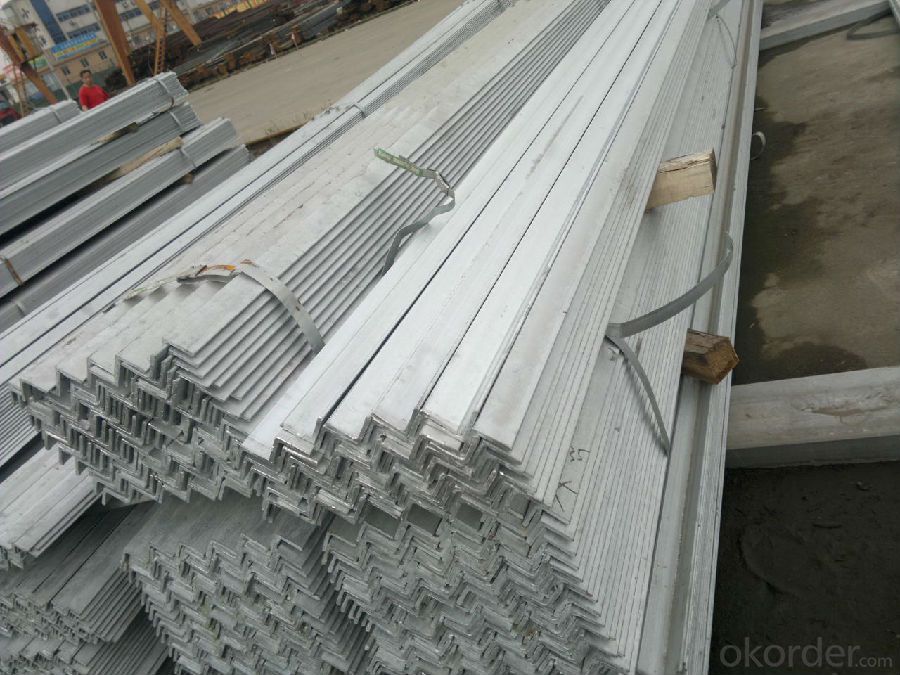
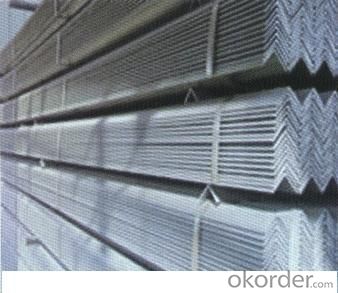
- Q: What is the weight-bearing capacity of steel angles?
- The weight-bearing capacity of steel angles is determined by a range of factors, including the angle's dimensions, thickness, the type of steel employed, and the specific load it bears. Due to their strength and load-bearing capabilities, steel angles find widespread use in construction and structural applications. Nevertheless, it is crucial to refer to engineering tables or seek guidance from a structural engineer to ascertain the precise weight-bearing capacity of a steel angle in a given scenario.
- Q: What are the considerations for selecting the appropriate steel angle finish?
- Several factors need to be taken into account when choosing the right steel angle finish. Firstly, the intended use or application of the steel angle is a primary consideration. Different finishes offer varying levels of corrosion resistance, which is crucial in environments with moisture or chemicals. For outdoor applications or high humidity environments, a hot-dip galvanized finish is often preferred due to its excellent corrosion resistance. Conversely, a plain steel finish may suffice for indoor applications where corrosion resistance is not a major concern. The desired aesthetic appearance is another consideration. Steel angles can be finished in different ways to achieve various looks. A mill finish provides a raw, industrial appearance, while a powder coat finish offers a polished look and a wide range of color options. The choice of finish depends on the desired aesthetic effect and the overall project design. Durability is also an important factor to consider. Finishes like zinc plating or stainless steel offer enhanced durability and resistance to wear and tear, making them suitable for heavy-duty applications or high-traffic areas. On the other hand, a painted finish may be more prone to chipping or scratching, making it less suitable for long-term durability requirements. Lastly, cost plays a significant role in the decision-making process. Different finishes have varying costs associated with them, so it is necessary to balance the desired finish with the available budget. It is worth noting that while certain finishes may have a higher upfront cost, they may provide long-term cost savings by reducing maintenance or replacement needs. To summarize, the appropriate steel angle finish selection depends on factors such as corrosion resistance, aesthetic appearance, durability requirements, and budget considerations. By carefully evaluating these factors, one can choose the most suitable finish that meets both functional and aesthetic needs.
- Q: What is the maximum length of a steel angle that can be transported?
- The maximum length of a steel angle that can be transported depends on various factors, including transportation regulations and limitations, the size and capacity of the transport vehicle, and any logistical constraints. In general, standard transport vehicles like trucks or trailers can typically accommodate steel angles up to a certain length, often around 40 feet (12.2 meters). These vehicles may have limitations on the length of cargo they can carry due to road transportation regulations or physical constraints. However, it's important to note that specialized transport options, such as flatbed trucks or lowboy trailers, may be available to accommodate longer steel angles. These specialized vehicles are designed to carry oversized or heavy loads and may have extended cargo beds or adjustable trailers to accommodate longer lengths. Ultimately, the maximum length of a steel angle that can be transported will vary depending on the specific circumstances and available transport options. It is recommended to consult with transportation professionals or logistics experts to determine the best and most suitable means of transporting steel angles of varying lengths.
- Q: Can steel angles be used in high-rise or multi-story buildings?
- Certainly, high-rise or multi-story buildings can incorporate steel angles into their structures. Construction often relies on steel angles because of their exceptional strength, versatility, and cost-effectiveness. When it comes to high-rise buildings, steel angles find extensive use in various structural components like beams, columns, and bracing systems. These angles effectively facilitate load and force transfer within the building, significantly enhancing overall stability and structural integrity. Furthermore, the fabrication and installation of steel angles are convenient, enabling efficient construction processes for large-scale projects. Consequently, steel angles enjoy broad acceptance and application in the construction of high-rise or multi-story buildings.
- Q: How much is a galvanized angle L50*50*5*2500
- The ordinary angle iron is 40-45 yuan one
- Q: Are steel angles suitable for reinforcing concrete structures?
- Indeed, steel angles prove to be a suitable option when it comes to reinforcing concrete structures. In construction projects, it is common to employ steel angles in order to provide additional support and strength to concrete structures. Their versatility and ease of fabrication and installation make them a favored choice for reinforcement purposes. The incorporation of steel angles aids in enhancing the structural integrity of concrete structures, thereby increasing their capacity to bear heavy loads and resist bending and shearing forces. Moreover, the dimensions and specifications of steel angles can be tailored to meet the unique requirements of different concrete structures, offering personalized reinforcement solutions. All in all, utilizing steel angles as reinforcement is a dependable and efficient approach to enhance the performance and longevity of concrete structures.
- Q: What is the maximum allowable lateral torsional buckling stress for a steel angle?
- The maximum stress that a steel angle can withstand before lateral torsional buckling occurs depends on several factors, including the angle's size, shape, material properties, and the design code being followed. To determine the maximum allowable stress for a steel angle, one can consider the critical moment of inertia and its corresponding critical stress. The critical moment of inertia measures the angle's ability to resist lateral torsional buckling and is affected by its geometry and dimensions. Design codes such as the AISC Manual of Steel Construction or the Eurocode provide specific values for the maximum allowable lateral torsional buckling stress. These codes offer guidelines and formulas for calculating this stress based on the angle's dimensions, material properties, and other factors like effective length and end conditions. To accurately determine the maximum allowable lateral torsional buckling stress for a particular steel angle, it is crucial to refer to the appropriate design code or standard and seek advice from a structural engineer or consult relevant reference materials.
- Q: What are the different load-carrying capacities for steel angles?
- The load-carrying capacities for steel angles can vary depending on several factors such as the size and shape of the angle, the type of steel used, and the specific application or use case. Generally, load-carrying capacities for steel angles are determined by considering the maximum allowable stress or load that the angle can withstand without experiencing permanent deformation or failure. This is often expressed in terms of the maximum axial or bending load that an angle can support. To determine the load-carrying capacity of a specific steel angle, engineers and structural designers refer to industry standards and guidelines, such as the American Institute of Steel Construction (AISC) Manual of Steel Construction. These standards provide tables and formulas that take into account various factors such as the angle's dimensions, thickness, and moment of inertia to calculate its load-carrying capacity. It is important to note that load-carrying capacities for steel angles are typically specified for specific loading conditions and safety factors. These factors include the type of load (e.g., axial or bending), the direction and magnitude of the applied load, and the safety factor required to ensure the structural integrity and durability of the angle. Therefore, it is essential to consult the relevant codes, standards, and engineering resources to determine the specific load-carrying capacity of a particular steel angle for a given application. Professional structural engineers and designers are best equipped to assess and determine the load-carrying capacities of steel angles based on their expertise and familiarity with the applicable design codes and standards.
- Q: What is the cost of steel angles compared to other materials?
- The price of steel angles compared to other materials can differ based on various factors such as the grade and type of steel, market conditions, and availability. Nevertheless, in general, steel angles are typically a cost-effective choice when compared to other materials commonly utilized for structural or construction purposes. Steel angles find extensive use in numerous industries, including construction, manufacturing, and infrastructure, owing to their durability, strength, and versatility. When compared to materials like aluminum or stainless steel, steel angles are often more economical. This is due to the wide availability of steel as a material and its ability to be manufactured in large quantities, resulting in cost efficiencies in the production process. Moreover, steel angles have a lengthy lifespan and necessitate minimal upkeep, further enhancing their cost-effectiveness over time. They also possess exceptional load-bearing capabilities, making them suitable for a broad range of applications, including building frames, support structures, and machinery. However, it is crucial to note that the cost of steel angles can still fluctuate depending on the specific requirements and specifications of a project. Factors such as size, length, thickness, and any additional treatments or finishes can impact the price. Therefore, it is advisable to consult with suppliers or manufacturers to obtain accurate and up-to-date pricing information based on the individual needs of the project.
- Q: How do you handle and install steel angles on a construction site?
- To handle and install steel angles on a construction site, one must carefully plan and pay attention to detail. Here is a breakdown of the necessary steps: 1. Site preparation: Before handling steel angles, it is crucial to properly prepare the construction site. This involves clearing debris and obstructions, ensuring a stable and level surface, and taking necessary safety precautions. 2. Measurement and marking: Accurate measurements of the steel angles' dimensions and their placement on the site are essential. Use a measuring tape to determine length, width, and thickness, and mark their intended locations. This guarantees proper alignment and fit during installation. 3. Handling and transport: Steel angles can be heavy, so it is important to use appropriate lifting equipment like cranes, hoists, or forklifts. Ensure that the lifting equipment is rated correctly and operated by trained personnel to prevent accidents or damage to the steel angles. 4. Securing the angles: Once the steel angles are in place, use suitable fasteners such as bolts, screws, or welding to secure them. The choice of fasteners depends on the project's requirements and the load-bearing capacity of the steel angles. Follow manufacturer guidelines and industry standards for proper fastener selection and installation. 5. Alignment and leveling check: After securing the angles, use a level and measuring tools to check their alignment and levelness. This step ensures correct installation and the necessary structural support. 6. Inspection and reinforcement: Thoroughly inspect the installed steel angles to ensure they are free from defects or damages. If any issues are found, take appropriate action to reinforce or replace the angles, maintaining the site's structural integrity. 7. Ongoing maintenance: Regular maintenance is necessary to extend the lifespan of steel angles and prevent corrosion. Follow manufacturer recommendations and periodically inspect the angles to address any issues promptly. In conclusion, handling and installing steel angles on a construction site require careful planning, proper equipment, and adherence to safety guidelines. By following these steps, construction professionals can ensure successful installation, contributing to the overall strength and stability of the structure.
Send your message to us
DIN1028 galvanized angle steel for construction
- Loading Port:
- Tianjin
- Payment Terms:
- TT OR LC
- Min Order Qty:
- 25 m.t.
- Supply Capability:
- 10000 m.t./month
OKorder Service Pledge
OKorder Financial Service
Similar products
Hot products
Hot Searches
Related keywords
